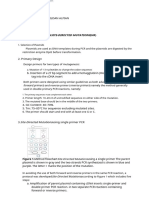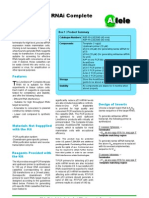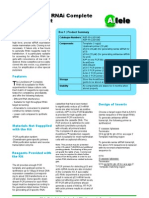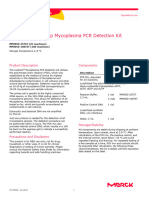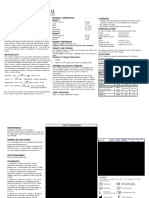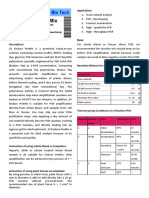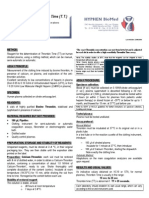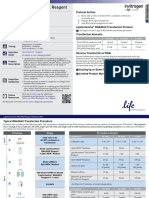ShRNA Protocol
ShRNA Protocol
Uploaded by
kate2494Copyright:
Available Formats
ShRNA Protocol
ShRNA Protocol
Uploaded by
kate2494Original Description:
Copyright
Available Formats
Share this document
Did you find this document useful?
Is this content inappropriate?
Copyright:
Available Formats
ShRNA Protocol
ShRNA Protocol
Uploaded by
kate2494Copyright:
Available Formats
shRNA Transfection Protocol Santa Cruz Biotechnology, Inc.
In a six well tissue culture plate, grow cells to a 50-70% confluency in Incubate the cells for an additional 18-24 hours under conditions normally
antibiotic-free normal growth medium supplemented with FBS. used to culture the cells.
NOTE: This protocol is recommended for a single well from a 6 well tissue OPTIONAL: For transient transfection, aspirate media and replace with fresh
culture plate. Adjust cell and reagent amounts proportionately for wells or 1x normal growth medium. Assay the cells using the appropriate protocol
dishes of different sizes. 24-72 hours after the addition of fresh medium in the previous step.
NOTE: Healthy and subconfluent cells are required for successful transfection For selection of stably transfected cells, proceed with puromycin selection
experiments. It is recommended to ensure cell viability one day prior to trans- as follows:
fection.
NOTE: The working puromycin concentration for mammalian cell lines
Prepare the following solutions: ranges from 1-10 g/ml. Prior to using the puromycin antibiotic (sc-108071),
titrate the selection agent to determine the optimal concentration for target
NOTE: The optimal shRNA Plasmid DNA:shRNA Plasmid Transfection Reagent
cell line. Use the lowest concentration that kills 100% of non-transfected
ratio should be determined experimentally beginning with 1 g of shRNA
cells in 3-5 days from the start of puromycin selection.
Plasmid DNA and between 1.0 and 6.0 l of shRNA Plasmid Transfection
Reagent as outlined below. Once the optimal shRNA Plasmid DNA:shRNA 48 hours post-transfection, aspirate the medium and replace with fresh
Plasmid Transfection Reagent ratio has been identified for a given cell medium containing puromycin at the appropriate concentration.
type, the appropriate amount of shRNA Plasmid DNA/shRNA Plasmid
Approximately every 2-3 days, aspirate and replace with freshly prepared
Transfection Reagent complex used per well should be tested to deter-
selective media.
mine which amount provides the highest level of transfection efficiency.
For example, if the optimal shRNA Plasmid DNA:shRNA Plasmid Transfection NOTE: Controls should always be included in shRNA experiments. Control
Reagent ratio is 1 g:1 l, then amounts ranging from 0.5 g/0.5 l to shRNAs are available as 20 g of plasmid DNA. Each encode a scrambled
2.0 g/2.0 l should be tested. shRNA sequence that will not lead to the specific degradation of any
known cellular mRNA. Control shRNA Plasmids include: sc-108060,
Solution A: For each transfection, dilute 10 l of resuspended shRNA
sc-108065 and sc-108066 (see below).
Plasmid DNA (i.e. 1 g shRNA Plasmid DNA) into 90 l shRNA Plasmid
Transfection Medium: sc-108062. NOTE: For Western blot analysis prepare cell lysate as follows: Wash
cells once with PBS. Lyse cells in 300 l 1x Electrophoresis Sample Buffer
Solution B: For each transfection, dilute 1 - 6 l of shRNA Plasmid
(sc-24945) by gently rocking the 6 well plate or by pipetting up and down.
Transfection Reagent: sc-108061 with enough shRNA Plasmid Transfection
Sonicate the lysate on ice if necessary.
Medium: sc-108062 to bring final volume to 100 l.
NOTE: For RT-PCR analysis isolate RNA using the method described by P.
NOTE: Do not add antibiotics to the shRNA Plasmid Transfection Medium:
Chomczynski and N. Sacchi (1987. Single-step method of RNA isolation by
sc-108062.
acid guanidinium thiocyanate-phenol-chloroform extraction. Anal. Biochem.
NOTE: Optimal results may be achieved by using siliconized microcentrifuge 162: 156-159) or a commercially available RNA isolation kit.
tubes.
Add the shRNA Plasmid DNA solution (Solution A) directly to the dilute shRNA SUPPORT REAGENTS
shRNA Plasmid Transfection Reagent (Solution B) using a pipette. Mix PRODUCT CAT. # DESCRIPTION AMOUNT
gently by pipetting the solution up and down and incubate the mixture shRNA Plasmid sc-108061 Delivers shRNA Plasmid DNA into cells with minimal cell 0.2 ml
Transfection toxicity; enables highly efficient shRNA Plasmid DNA trans- 50-100
15-45 minutes at room temperature. Reagent fection in a variety of cell lines including CHO-K1, COS, LNCaP, transfections
NIH/3T3, 293, T24, C2C12, SF-9, primary human keratiocytes,
Wash the cells twice with 2 ml of shRNA Transfection Medium: sc-108062. primary aortic smoothmuscle, primary rabbit myoblasts, human
bone marrow endothelial cells (HBMEC).
Aspirate the medium and proceed immediately to the next step.
shRNA Plasmid sc-108062 Reduced-serum medium suitable for addition to shRNA 20 ml
NOTE: Do not use PBS as the residual phosphate may compete with DNA and Transfection suspension and shRNA Transfection Reagent immediately
Medium prior to cell transfection; modification of Eagles Minimal
bind the shRNA Plasmid Transfection Reagent, thereby reducing the transfec- Essential Medium, buffered with HEPES and sodium
bicarbonate, and supplemented with hypoxanthine,
tion efficiency. thymidine, sodium pyruvate, L-glutamine, trace elements,
growth factors and phenol red.
For each transfection, add 0.8 ml shRNA Plasmid Transfection Medium to
Control shRNA sc-108060 Control shRNA Plasmid-A is a negative control for experi 20 g
well. Plasmid-A ments using targeted shRNA transfection which encodes 20
a scrambled shRNA sequence that will not lead to the specific transfections
Add the 200 l shRNA Plasmid DNA/shRNA Plasmid Transfection Reagent degradation of any known cellular mRNA.
Complex (Solution A + Solution B) dropwise to well, covering the entire layer. Control shRNA sc-108065 Control shRNA Plasmid-B is available as an alternate 20 g
Plasmid-B negative scrambled shRNA sequence control. 20
Gently mix by swirling the plate to ensure that the entire cell layer is transfections
immersed in solution. Control shRNA sc-108066 Control shRNA Plasmid-C is available as an alternate 20 g
Plasmid-C negative scrambled shRNA sequence control. 20
transfections
Incubate the cells 5-7 hours at 37 C in a CO2 incubator or under conditions
normally used to culture the cells. Longer transfection times may be desirable shRNA Plasmid support reagents are optimal for successful delivery of Santa Cruz Biotechnology, Inc.s shRNA Gene
Silencing Plasmids into mammalian cells. Amounts listed above are based on use of 6-well plates.
depending on the cell line.
Following incubation, add 1 ml of normal growth medium containing 2
times the normal serum and antibiotics concentration (2x normal growth
medium).
Santa Cruz Biotechnology, Inc. 1.800.457.3801 831.457.3800 fax 831.457.3801 Europe +00800 4573 8000 49 6221 4503 0 www.scbt.com
You might also like
- Genome Res.-1991-Golay-144-5Document3 pagesGenome Res.-1991-Golay-144-5Omeyya TanveerNo ratings yet
- Rnasimple Total Rna KitDocument7 pagesRnasimple Total Rna KitHicha LidyaNo ratings yet
- Basic Sirna Resuspension ProtocolDocument2 pagesBasic Sirna Resuspension ProtocolPratik KulkarniNo ratings yet
- Amrizal Shalahudin - 20106040026 - Tahapan-Tahapan Metode Site-Directed Mutagenesis - Id.en PDFDocument3 pagesAmrizal Shalahudin - 20106040026 - Tahapan-Tahapan Metode Site-Directed Mutagenesis - Id.en PDFWildan AlfianNo ratings yet
- TRI: A N R O S - S I RNA: ZOL EW Eagent For Ptimal Ingle TEP Solation ofDocument4 pagesTRI: A N R O S - S I RNA: ZOL EW Eagent For Ptimal Ingle TEP Solation ofedisonballaNo ratings yet
- Muhammad Wildan Alfian - 20106040023 - Tahapan-Tahapan Metode Site-Directed Mutagenesis - Id.en PDFDocument3 pagesMuhammad Wildan Alfian - 20106040023 - Tahapan-Tahapan Metode Site-Directed Mutagenesis - Id.en PDFWildan AlfianNo ratings yet
- Primescript™ Reverse Transcriptase: Code No. 2680Q Size: 2,000 Units Shipping at 20 Store at 20Document2 pagesPrimescript™ Reverse Transcriptase: Code No. 2680Q Size: 2,000 Units Shipping at 20 Store at 20Isaac Nicholas NotorioNo ratings yet
- Rna Zol ProtocooDocument3 pagesRna Zol Protocoorajha vikneshNo ratings yet
- Production of Dsrna Using Bacteriophage 6Document11 pagesProduction of Dsrna Using Bacteriophage 6Basma RagabNo ratings yet
- Description: Sensifast™ Cdna Synthesis KitDocument2 pagesDescription: Sensifast™ Cdna Synthesis KitDevin HendrawanNo ratings yet
- LineSilence RNAi Mouse Expression KitDocument3 pagesLineSilence RNAi Mouse Expression KitAlleleBiotechNo ratings yet
- Superscript Iii One-Step RT-PCR System With Platinum High Fidelity Dna PolymeraseDocument4 pagesSuperscript Iii One-Step RT-PCR System With Platinum High Fidelity Dna PolymeraseBirukNo ratings yet
- Thermo Scientific Revertaid Reverse Transcriptase: Lot: - Expiry DateDocument4 pagesThermo Scientific Revertaid Reverse Transcriptase: Lot: - Expiry Dateinvestbiz optionstarNo ratings yet
- Superscript Onestep Long ManDocument4 pagesSuperscript Onestep Long ManTay MrNo ratings yet
- Week 6 Generating RNA W20 RRG T7Document3 pagesWeek 6 Generating RNA W20 RRG T7Empowering YouthNo ratings yet
- 3.2. Chemicals and Reagents: 4. Detailed ProcedureDocument3 pages3.2. Chemicals and Reagents: 4. Detailed Procedurenino bendelianiNo ratings yet
- L00689 ManualDocument4 pagesL00689 ManualSiriporn SRIPINYOWANICHNo ratings yet
- Clinical Lab PracticeDocument36 pagesClinical Lab PracticeiqrarNo ratings yet
- Lentiviral Transduction ProtocolDocument4 pagesLentiviral Transduction ProtocolSigma-Aldrich100% (2)
- C-Reactive Protein DeterminationDocument3 pagesC-Reactive Protein DeterminationIsabelle DavidNo ratings yet
- Reverse Transcription - Polymerase Chain Reaction: ProtocolDocument10 pagesReverse Transcription - Polymerase Chain Reaction: ProtocolArnold Jr BautistaNo ratings yet
- Line Silence RNAi Complete Expression KitDocument3 pagesLine Silence RNAi Complete Expression KitAlleleBiotechNo ratings yet
- QPCR SopDocument7 pagesQPCR SopAna Marina SantosNo ratings yet
- Basic Sirna Resuspension ProtocolDocument2 pagesBasic Sirna Resuspension ProtocolSandeep Kumar BansalNo ratings yet
- mp0050 MKDocument6 pagesmp0050 MKRayane Teles de FreitasNo ratings yet
- Commercial Transfection Reagent ComparisonDocument9 pagesCommercial Transfection Reagent ComparisonA INo ratings yet
- In Situ HybridizationDocument6 pagesIn Situ Hybridizationn7s77hxzbtNo ratings yet
- Berichrom - Antiplasmin Berichrom (ANTIPLASMIN) : Intended Use Summary and Explanation ProcedureDocument8 pagesBerichrom - Antiplasmin Berichrom (ANTIPLASMIN) : Intended Use Summary and Explanation ProcedureTony AquinoNo ratings yet
- Types of PCR-1Document31 pagesTypes of PCR-1Ahmad KarimNo ratings yet
- Group 12 Writing Article 8Document4 pagesGroup 12 Writing Article 8Đoàn KhangNo ratings yet
- Detailed Procedure: 4.1. Total RNA Extraction From Human Brain TissueDocument4 pagesDetailed Procedure: 4.1. Total RNA Extraction From Human Brain Tissuenino bendelianiNo ratings yet
- Inverse PCRDocument6 pagesInverse PCRHiromi UchimaNo ratings yet
- XL AdaDocument2 pagesXL AdaDinesh SreedharanNo ratings yet
- 4 - Apa478 Clase 4 DNA2Document41 pages4 - Apa478 Clase 4 DNA2MARCELO IGNACIO CORREA ZUNIGANo ratings yet
- PCR Mycoplasma Test Kit I/C: Instruction ManualDocument8 pagesPCR Mycoplasma Test Kit I/C: Instruction ManualAslam MikraniNo ratings yet
- Viva 2 StepsDocument4 pagesViva 2 StepsElimar CarreonNo ratings yet
- HB-2424-001-1107848 LL miRCURY LNA RT 0917 WWDocument4 pagesHB-2424-001-1107848 LL miRCURY LNA RT 0917 WWvickyvania1995No ratings yet
- Lab 2Document3 pagesLab 2Gana KhaledNo ratings yet
- RT-PCR ProtocolDocument3 pagesRT-PCR ProtocolSusheeNo ratings yet
- Serological Tests For Diagnosing Syphillis: SyphilisDocument2 pagesSerological Tests For Diagnosing Syphillis: SyphilisthedarkwingNo ratings yet
- superscriptIII onestepRTPCR ManDocument4 pagessuperscriptIII onestepRTPCR ManGustavo HoppeNo ratings yet
- RDT PracticalDocument9 pagesRDT PracticalBoka PolaNo ratings yet
- Enduro DatasheetDocument1 pageEnduro DatasheetTenGigaBioNo ratings yet
- WT1 GENE MUTATION ProjectDocument12 pagesWT1 GENE MUTATION ProjectSoumya Ranjan SwainNo ratings yet
- Purelink Rna Mini Kit QRCDocument4 pagesPurelink Rna Mini Kit QRCIsaac Nicholas NotorioNo ratings yet
- Extraction Methods For NADDocument9 pagesExtraction Methods For NADMiruna StanNo ratings yet
- REPORT HEV Detection by Real Time RT PCRDocument4 pagesREPORT HEV Detection by Real Time RT PCRmai.phn2001No ratings yet
- Prostate Specific Antigen (PSA) : Enzyme Immunoassay Test Kit Catalog Number: 10109Document4 pagesProstate Specific Antigen (PSA) : Enzyme Immunoassay Test Kit Catalog Number: 10109yousrazeidan19790% (1)
- SCRIPT Reverse TranscriptaseDocument3 pagesSCRIPT Reverse Transcriptaseinvestbiz optionstarNo ratings yet
- Anti-Rap1: Certificate of AnalysisDocument3 pagesAnti-Rap1: Certificate of AnalysisTheo PigaglioNo ratings yet
- Analiza PCR - ThermocyclerDocument7 pagesAnaliza PCR - Thermocyclerionescu_ion_3No ratings yet
- DNA Xpress ReagentDocument7 pagesDNA Xpress Reagenthar2dikNo ratings yet
- CDNA SynthesisDocument17 pagesCDNA SynthesissamaNo ratings yet
- Thrombin TimeDocument2 pagesThrombin Timesofia anneNo ratings yet
- 3bsmt1 Bobier, Ashwelldonne Molbio PCRDocument9 pages3bsmt1 Bobier, Ashwelldonne Molbio PCRAshwell Donne BobierNo ratings yet
- RNAiMAX Reag ProtocolDocument2 pagesRNAiMAX Reag Protocolnaveenmi2No ratings yet
- Zhang2018transcriptome Sequencing RNA-SeqDocument13 pagesZhang2018transcriptome Sequencing RNA-SeqKito TongHuiNo ratings yet
- Brief Notes On Polymerase Chain Reaction (PCR) : 2 Year MT Molecular Biology Lab 2010Document5 pagesBrief Notes On Polymerase Chain Reaction (PCR) : 2 Year MT Molecular Biology Lab 2010kinantiNo ratings yet
- Single-Step Method of RNA Isolation by Acid Guanidinium Thiocyanate-Phenol-Chloroform ExtractionDocument4 pagesSingle-Step Method of RNA Isolation by Acid Guanidinium Thiocyanate-Phenol-Chloroform ExtractionAnggraeni Arum SNo ratings yet
- Sarstedt Environmental PolicyDocument2 pagesSarstedt Environmental Policykate2494No ratings yet
- The Social and Environmental Impact of Engineering Solutions: From The Lab To The Real W Orld PDFDocument14 pagesThe Social and Environmental Impact of Engineering Solutions: From The Lab To The Real W Orld PDFkate2494No ratings yet
- Fumecupboard Sticker PDFDocument1 pageFumecupboard Sticker PDFkate2494No ratings yet
- Laboratory Safety SymbolsDocument5 pagesLaboratory Safety Symbolskate2494100% (1)
- Sash Stickers GreenLabsDocument4 pagesSash Stickers GreenLabskate2494No ratings yet
- Sigma SaponinDocument3 pagesSigma Saponinkate2494No ratings yet
- UN3373 Biological Substance, Category B Packed in Dry Ice by Air Authority LetterDocument1 pageUN3373 Biological Substance, Category B Packed in Dry Ice by Air Authority Letterkate2494No ratings yet
- UKCAT OfficialGuide 2015Document84 pagesUKCAT OfficialGuide 2015kate2494No ratings yet
- RNAi Drug ListDocument26 pagesRNAi Drug ListCarrieNo ratings yet
- Bacterial Modification and Cancer TherapyDocument7 pagesBacterial Modification and Cancer TherapyAndrés Felipe Galindo MantillaNo ratings yet
- Si RNADocument29 pagesSi RNALuis MonteroNo ratings yet
- MISSION Lentiviral Transduction Particles (SHVRS) - Technical BulletinDocument4 pagesMISSION Lentiviral Transduction Particles (SHVRS) - Technical BulletinSigma-Aldrich100% (1)
- NBT 1547Document12 pagesNBT 1547walshmj75100% (2)
- Assessment of Tumor Response To Percutaneous Ablation by Using Glyceraldehyde-3-Phosphate Dehydrogenase AntagonistsDocument12 pagesAssessment of Tumor Response To Percutaneous Ablation by Using Glyceraldehyde-3-Phosphate Dehydrogenase Antagonistsnguyen hoang nganNo ratings yet
- Anti Sense - InhibitionDocument25 pagesAnti Sense - InhibitionSanthoshi Sadhanaa SankarNo ratings yet
- Host - Guest Chemistry in Supramolecular Theranostics: T H e R A N o S T I C SDocument34 pagesHost - Guest Chemistry in Supramolecular Theranostics: T H e R A N o S T I C SLizbethNo ratings yet
- Exploiting Bacteria For Cancer Immunotherapy: Clinical OncologyDocument21 pagesExploiting Bacteria For Cancer Immunotherapy: Clinical Oncologyp vsNo ratings yet
- Resistance To Wheat Streak Mosaic Virus Generated by Expression of An Artificial Polycistronic Microrna in WheatDocument14 pagesResistance To Wheat Streak Mosaic Virus Generated by Expression of An Artificial Polycistronic Microrna in WheatMuhammad FahimNo ratings yet
- Jurnal Protein SitoplasmaDocument13 pagesJurnal Protein SitoplasmadeyaNo ratings yet
- ShRNA ProtocolDocument1 pageShRNA Protocolkate2494No ratings yet





